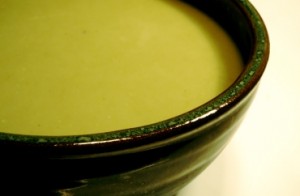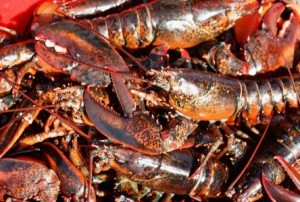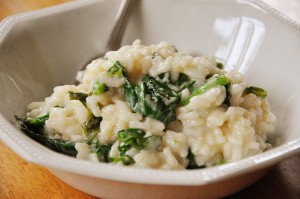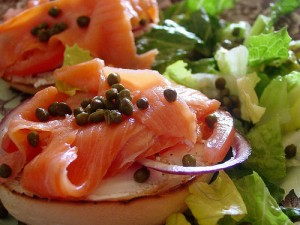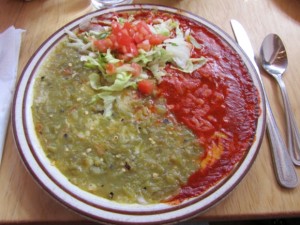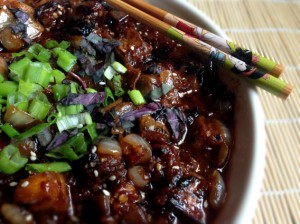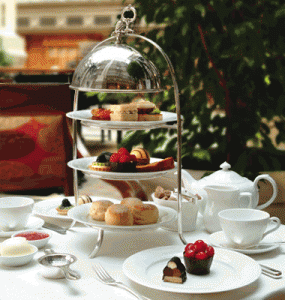Fifty years ago, ratatouille was a fashionable dish. It was a mark of culinary sophistication to pronounce the word properly: Rat-a-too-ee. Then it disappeared from the dinner tables of the fashionable and the menus of chic restaurants. HG is pleased that BSK, a culinary classicist, keeps it alive. One of HG’s favorite luncheon dishes is a bowl of room temperature ratatouille topped with three or four anchovy fillets and a few black kalamata olives. Somehow it evokes summer. It should. Its origin is Provence, southern France. Its birthplace is Nice. In fact, the full name of the dish is “ratatouille nicoise.” BSK’s version of the dish is delicious. Each ingredient (olive oil, garlic, onion, eggplant, zucchini, red bell pepper, tomato, parsley, basil, thyme) is top quality ans treated as such. BSK cooks the vegetables in a sequence BSK has devised (tomatoes go in last). This means all the flavors merge but each retains an individual vibrancy. Keeps well in the refrigerator. Gets better with time. HG has never fancied ratatouille as a side dish with fish or meat. It’s a stand alone treat.
Ratatouille
July 10th, 2014 § 0 comments § permalink
Summer Heat Beater: Schav
July 6th, 2014 § 0 comments § permalink
HG has noted previously that BSK has cultivated a lush crop of sorrel. BSK makes very good sorrel soup in the French manner. Thickened and enriched with a touch of sweet cream, it is the perfect sauce for grilled or poached salmon. Vaudeville, the art deco Paris brasserie, served a very good version (before the brasserie went downhill under chain management). However, HG’s favorite use of sorrel is in “schav”, the ice cold, refreshingly sour sorrel soup as it was prepared by HG’s Mom and served in New York Jewish “dairy” restaurants (and Catskills resorts) in years gone by. Topped with some sour cream, this soup conquers summer heat. Accompanied by a boiled potato, this was often HG’s boyhood summer lunch in The Bronx and Rockaway. Weather has been hot and humid on PEI. HG”s palate cried out for schav. So, consulting the Jew and Carrot food blog, HG made a jar of schav. Very good. But, it lacked something, A bite of sourness. What was Mom’s secret? Memory was racked. The answer: Rokeach Sour Salt. Essentially citric acid, this is what Mom added to her schav, exemplary beet borscht, robust cabbage borscht and savory ground meat stuffed cabbage in sweet and sour sauce. Yes, Rokeach still provides sour salt and HG is waiting for a supply from Amazon.
Unfairly Unpopular Eels
July 2nd, 2014 § 0 comments § permalink
HG has had an interest in eels ever since HG learned that Freud, an HG hero, spent a youthful year researching the snake-like sea creature. The appearance of eels tend to turn off a great number of folks; but, they are nutritious, delicious and in Japan, where unagi is a favorite food, they are lauded as being an aid to vitality and longevity (the maternal grandfather of Exquiiste Maiko — HG’s Japanese daughter-in-law and favorite home chef — lived to be 100 and ate eel almost every day). HG enjoys unagi sushi at Shohko Cafe, the very good Japanese restaurant in Santa Fe. HG used to obtain unagi at Whole Foods and enjoy it as part of a sashimi platter. HG also liked to top a bowl of rice with much sliced unagi. Alas, Whole Foods no longer carries unagi and HG can’t find a good online source. However, the best eel dish HG ever experienced was at yesteryear’s great French restaurant, Henri Soule’s Le Pavillon. Soule served lightly smoked filets of eel with whipped cream spiked with lots of freshly grated, strong horse radish. Divine. Eel remains popular with London’s working class who enjoy jellied eels and patronize some of the city’s few remaining eel-and-pie restaurants. HG fears that this eel dish may be a specialized English taste like mushy peas, Marmite and the chip butty.
Lobster Time On PEI
June 26th, 2014 § 0 comments § permalink
Okay, food loving pals, turn green with envy. It’s lobster season here on Prince Edward Island and fresh caught lobster sells for $5 to $7 a pound — it seems that slightly warming waters has expanded the lobster population. The ocean directly in front of the HG/BSK home is teeming with the crustaceans and HG/BSK awaken each morning to the sight of a dozen lobster boats chugging about in front of their windows. Seems to be an early morning activity because by 11 AM they’re all gone. HG is taking advantage of this surplus and devouring many delicious lobsters in a variety of styles: Steamed and dipped in melted butter (garnished with lemon juice and Frank’s Hot Sauce). Mixed with chopped celery and mayonnaise and stuffed into lightly toasted frankfurter rolls. Scooped into Belgian endive leaves. None of this brings joy to BSK. The love of HG’s life is allergic to lobsters and all other crustaceans (shrimp, crab, langoustines). BSK is not allergic to bivalves (oysters, clams, scallops). So, there’s a lot of good sea stuff for BSK to relish. But, BSK still looks at HG with wistful envy as the greedy old guy knocks off some juicy lobster.
Risotto By The Master
May 5th, 2014 § 1 comment § permalink
HG has never had really good risotto in a restaurant. It figures. Risotto requires patience. Steaming chicken (or beef) broth has to be added to rice spoonful by spoonful. The liquid has to be absorbed before any additional liquid is added. HG, a risotto master, takes at least 20 minutes to a half hour to produce a pot of risotto that combines slightly al dente rice gilded by creamy starch and delicious fats. Can’t be pre-cooked. Can’t be reheated. HG/BSK eat it the moment the pot is removed from the range. Anyway, here’s a step by step recipe for the lush spinach risotto HG/BSK ate last night: First, start with Italian Carnaroli rice a.k.a. The King Of RIces (okay, in a pinch you can use Arborio). Best Carnaroli brand is Riso Bello. The process starts with gently cooking chopped onion in butter and olive oil. When the onion has softened, stir in a cup of rice. Stir for a few minutes over low heat allowing the fats to coat each grain. Add a half cup of white wine and turn up the heat until the wine is absorbed by the rice. Meanwhile heat chicken stock (Trader Joe’s Free Range is the best). Add the heated stock ladle by ladle. Don’t hurry. Add only when previous ladleful is absorbed. Meanwhile saute baby spinach leaves in oil and a bit of garlic until the spinach is just wilted. About three or four minutes before the rice is done, add the spinach to the pot and stir. (At this juncture, if HG has a chunk of left over Parmesan in the refrigerator, HG cuts it into slices and tosses it into the pot). Two minutes before serving, HG tosses some grated Parmesan into the pot with a big chunk of butter. It all gets a final stir before being placed on the table and spooned into heated bowls. Additional Grated Parmesan to taste, freshly ground pepper, Maldon Smoked Sea Salt Flakes, a crisp, tossed salad and abundant hearty red wine. That’s the meal, folks, HG/BSK’s definition of home comfort. Not to be found in a restaurant.
Bagels? Feh!
May 4th, 2014 § 0 comments § permalink
Mark Bittman has a nice opinion piece in the New York Times about the perennial Holy Trio (pardon the sacrilege) of Jewish comfort food: Lox, Bagels, Cream Cheese. HG is a bit of a contrarian and curmudgeon on this subject. HG loathes bagels. HG shares this dislike with his late parents, both Jewish immigrants from Belorussia. Every Sunday morning throughout HG’s childhood, HG and his father would stroll to West Kingsbridge Road in The Bronx. They would separate. Father went to the “appetizing” store for Nova salmon, sable, sour pickles, black olives, cole slaw and potato salad. HG went to the bakery for bialys, onion rolls (pletzels) and sliced Jewish rye bread. (Mom had gone to Daitch Dairy the day before for cream cheese and baked farmer cheese). HG picked up the Sunday Times, Sunday News and the Yiddish-language Jewish Daily Forward. Home for the feast at a table with a steaming pot of coffee, a pitcher of freshly squeezed orange juice and a bottle of Hennessy Brandy. A morning of down home Jewish culinary delight. And, not a bagel in sight.
Christmas Every Day
April 30th, 2014 § 0 comments § permalink
Yes, it’s Christmas every day at Sopaipilla Factory, the exemplary comfort food restaurant dishing out New Mexican cuisine a 15-minute drive north of Santa Fe. HG lunches there at least twice a week. There’s a ritual. HG slides into a comfy booth. Felipe Garcia, the pleasant, welcoming proprietor, says: “Señor HG, enchilada or burrito? Christmas, as usual?” HG always orders chicken. An enchilada for light eating or a giant burrito when really hungry. “Christmas” has a specific meaning in Norte, the food language of Northern New Mexico. It means half the plate is smothered in green chile and half in red chile. Red and green. Christmas. Get it? At Sopaipilla Factory the red chile has plenty of heat while the green is mild and mellow. It is just the opposite at nearby El Parasol, another HG favorite. At Angelina’s in Espanola, the heat levels vary every day. Last time HG was there the waitperson warned HG about the green chile. “Picante !! Picante !!” HG tried it anyway. Mouth fire. So, when eating in Northern New Mexico ask about the heat levels of the two chiles but be sure to order “Christmas” if you want to have a tasty holiday.
Spicy Asian Eggplant
April 26th, 2014 § 0 comments § permalink
Yes, HG can eat (with appetite and judgment) but HG has learned (in later life) that HG can also cook. HG’s repertoire is quite limited. However, some of his dishes can be memorable. One that has received the BSK nod of approval is HG’s eggplant dish. HG browns cubes of Japanese eggplant in very hot vegetable oil. Removes the eggplant from the pan. Heats some more oil and softens a bunch of thinly sliced onion. When onion is soft adds lots of chopped garlic and stirs a bit. Then adds soy sauce, oyster sauce, some water, a spoonful or two of water, a sprinkling of sugar. Chili garlic sauce is added (use a generous amount if you want a blast of Szechuan heat). Eggplant goes back into the pan and it is simmered until the eggplant is tender and the sauce has thickened. Top it with ground black pepper, a drizzle of sesame oil and chopped scallions. HG likes to accompany it with BSK’s perfect white rice and crisp green salad.
A Nice Cup Of Tea
April 17th, 2014 § 2 comments § permalink
HG never drinks tea at an American restaurant. It’s vile. Sheer heaven is teatime at Brown’s or another estimable London hotel restaurant like the Savoy or Claridge’s, etc.. Ah, scones with clotted cream and strawberry preserves with properly brewed tea. SKF carries on English tradition by doing tea properly. Scalds the teapot with boiling water. Adds the good tea bags to the tea pot and covers them with boiling water. Nestles the teapot in a tea cozy (SKF uses a colorful cozy knit by her late grandmother). Lets the tea steep for an appropriate period. Pours it in a cup and adds a dash of milk. Very comforting. HG’s beloved late father, Hershele Tsvi Freimann, would frown at the addition of milk. He drank strong Russian style black tea with lemon. Held a sugar cube between his teeth as he sipped the brew. Sometimes he eliminated the lemon and added a big dollop of cherry preserves to his cup. That’s the way after dinner tea was served at the Russian Tea Room on W. 57th Street in New York. Try it. Delightful.
Macarons VS Macaroons
April 16th, 2014 § 0 comments § permalink
The Macaron, a light, melt-in-your-mouth, tiny pastry is one of the glories of French cuisine. Its polar opposite is the American Macaroon, a heavy lump of coconut, low-end chocolate and other vile ingredients, that makes its appearance in supermarkets during Jewish holidays and then, for the most part, disappears (thankfully) for a year. HG first discovered the macaroon at his Aunt Marie’s and Uncle Phillip’s home over the Passover holiday. Vaguely stale, chocolate waxy, it was an unpleasant, sweet diversion after the delicious ceremonial meal. HG/BSK first discovered the French Macaron during a Parisian vacation many decades ago. Chilly, rainy afternoon. HG/BSK ducked into Laduree on Rue Royale, the venerable (founded in 1862) tearoom. BSK had heard Laduree served the only good pot of tea in Paris. Correct. The steaming tea was comforting. But, the accompanying Macarons provided an incomparable treat. Laduree and its dazzling pastries was created by an extraordinary Frenchman, Louis-Ernest Laduree. The original Laduree bakery on Rue Royale was destroyed in the Paris Commune uprising but quickly rebuilt. Laduree was a miller. He was also a writer, a cutting satirist whose targets were intolerance, religious dogma and governmental excess. Undismayed by official disapproval, Laduree wrote some 20,000 letters and 2,000 books and pamphlets. His grandson, Pierre Desfontaines, added a tearoom to the original Laduree pastry shop in 1930 and it quickly became a favorite meeting place for fashionable Parisiennes. Groupe Holder took over Laduree in 1993. There are now scores of Laduree tearooms throughout the world (two in New York) that offer up the same wonderful Macarons. But, nothing quite has the charm of nibbling Macarons at the Original Laduree, preferably on a rainy afternoon.

